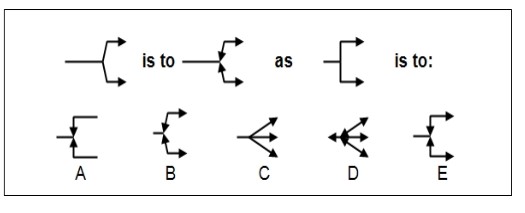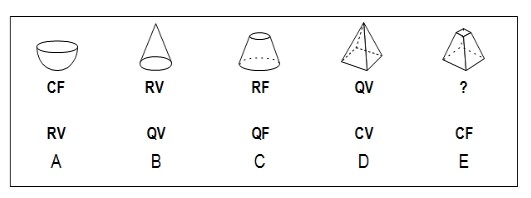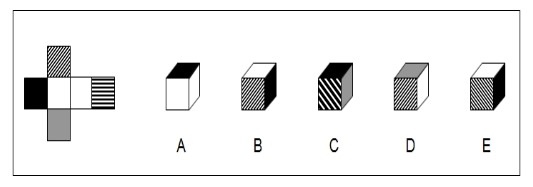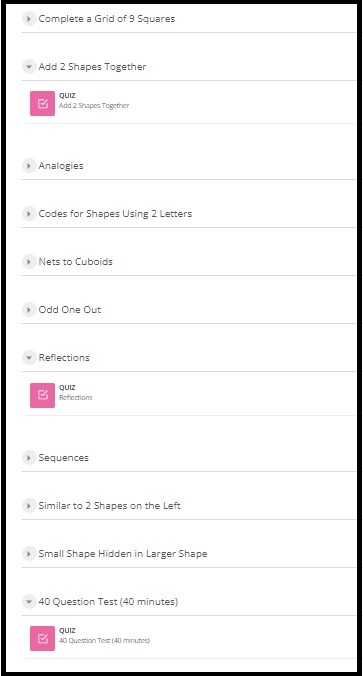Online 11+ Exam Non-Verbal Reasoning practice.
- Short, sharp practice
- Work at your child's own pace
- Less pressure and more preparation
The 11+ Non-Verbal Reasoning topics in this online site include:-
Analogies
In English it is easier to understand the relationships when an Analogy compares two things to each other. A simple example might be UP is to DOWN as RIGHT is to LEFT. These are opposites!
In Non-Verbal Reasoning analogies will be more difficult to explain but may include changes in shading, size, rotation or many other factors associated with shapes. Practice is essential to improve a child's skill in this topic. Your child will have to select the correct answer from a number of options like the example below.
The two shapes on the left are connected in some way.
The shape on the right is connected, in the same way, to one of the five choices given below.
Chose the correct letter from those given.

Codes for Shapes Using 2 Letters
In this question type there is a two letter code under each shape. Each letter gives you different information about some aspect of the shape.
Which two letter code is the correct code for the last shape?
Chose the correct letter from those given.

Complete a 9-square grid or matrix.
A question like this requires good observation to look for patterns in both a vertical & horizontal line. A difficult concept but one that can be improved with pressure free practice. The 9 square form a pattern of some sort and one of the options that your child is given will complete the pattern.
One of the smaller shapes will complete the grid. Decide which is the correct small shape.
Chose the correct letter from those given.

Add 2 Shapes Together
Develop your child's Non-Verbal Reasoning skill by encouraging them to improve observation and to look for size, shape and shading. They must also learn to look at the complete diagram.
You cannot rotate or change these two shapes in any way.
Choose the resultant shape from one of the five shapes given on the right.
One shape may be hiding part of the other shape.
Chose the correct letter from those given.

2-D Nets to 3-D cuboids.
A topic often covered during day to day maths and taught in schools during shape and space lessons.This question type helps your child recognise patterns and continue to develop their 11+ Non-Verbal Reasoning skills. Practical exercises will improve skill and knowledge if your child cuts and folds a 2-D net into its 3-D cuboid. Looking at the pattern is essential - looking where the pattern can't be is often as important as looking where the pattern goes.
Look at this example.
The net on the left can be folded into a cuboid. Chose the correct cuboid from the possibilities on the right.
Chose the correct letter from those given.

Odd One Out
How do shapes differ and why are diagrams similar?
If a shape is the odd one out then it is different, in some way, to the rest of the shapes. Why a shape is the odd one out could be to do with a reason or a combination of reasons such as rotation, reflection, its shading or the number of straight/curved lines used to make the shapes. Have a go at this example.
In this question you have to select the shape that is different in some way from the other four shapes.
Chose the correct letter from those given.

Reflections
Shapes seen in vertical mirrors or horizontal mirrors or maybe even mirrors on an angle. First thing to do is look at the detail. The shape will reflect and move from its original position using what is sometimes called a Vertical Flip or a Horizontal Flip. look at this example.
In this question, a shape is given to the left. The position of a mirror is shown by dotted lines.
Reflect the shape into this mirror, according to the mirror’s position. Choose one of the five shapes to the right that is the reflection of the shape on the left.

Chose the correct letter from those given.
Why use this 11+ online site?
Undertaking this 11+ Non-Verbal Reasoning course will increase the ability of your child to tackle the Non-Verbal Reasoning part of any 11 plus examination. The online course covers many of the most common question types used in 11+ Non-Verbal Reasoning exams.
No time is set for these practices allowing children to work at their own speed without the pressure of time constraints.
A pupil preparing with these questions in the security of their own home environment will be at a distinct advantage when sitting their 11 plus exam.
Suitable and relevant feedback is provided after the questions are answered and scored. If the question is not attempted then no feedback is given to the child - this process encourages your child to attempt to answer the question.
Additional practice is provided by timed tests consisting of 40 mixed questions.
This Non-Verbal Reasoning course forms part of the complete 11+ Exam preparation course.
When you subscribe to The complete 11+ course all four subject areas will appear in your "My courses " list and the screenshot below gives you an idea of what the Non-Verbal section will look like. The
Non-Verbal reasoning course is constructed in such a way so that you can open or close questions as required. You can also mark a question type as "done" when you feel that your child has mastered this particular question type.
This 11+ Non-Verbal Reasoning Course provides unlimited practice in many difficult areas of 11+ Non-Verbal Reasoning.

